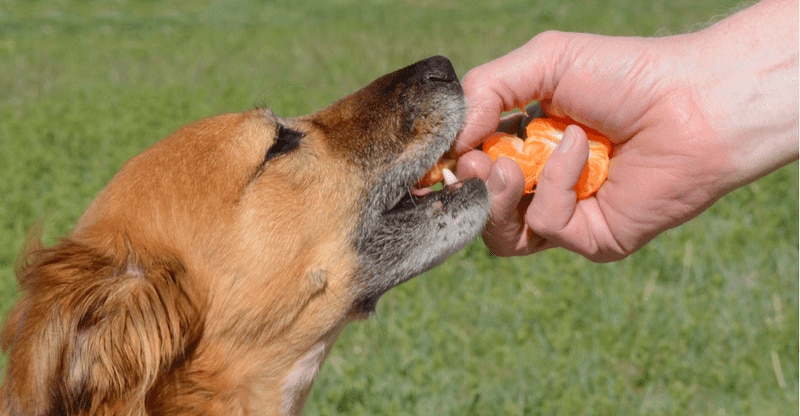Can Dogs Eat Oranges or Citrus Fruits?

Dogs can eat oranges as a treat, up to two slices, every other day. While some fruits like oranges, clementines, tangerines, and grapefruit are ok for dogs, they contain high amounts of sugar and acid that can cause gastrointestinal upset. Before serving oranges, check with your veterinarian.
How to prepare an orange for a dog
While oranges are ok for dogs in moderation, some parts of the fruit can make a dog sick, so be sure to follow these easy preparation instructions before feeding your dog any.
9 Step-by-step preparation instructions
Follow these steps if you want to share a slice of orange that is safe for your dog to eat.
- Remove the stem or leaves if you’re preparing fruit off a tree.
- Peel the orange rind off the fruit.
- Thoroughly clean off all the white skin from the orange.
- Split the fruit open, take off any remaining white stringy bits from the inside.
- Carefully cut the thinnest part of the slice open.
- Squeeze the orange slice gently and pop the seeds or pips out.
- Set two slices of orange aside for your dog and eat the rest.
- Cut your dog's orange slice into smaller pieces.
- Freeze the orange pieces as a summer treat or let your dog enjoy them fresh!
Are oranges bad for dogs?
Oranges are not bad for dogs, but just like most human foods safe for dogs to eat, they offer no significant nutritional benefit. In fact, the nutrient that oranges are most known for, vitamin C, is made naturally by dogs and cats, unlike humans.
A zesty, medium-sized orange contains high amounts of vitamin C from 100% to 130%, as well as, sugar and fiber up to 12%.
Sugar-rich fruit is never a good treat for diabetic dogs, although vitamin C and natural sugars are not harmful to dogs. Should a dog have more vitamin C that is necessary, its water-soluble capacity allows it to be easily expelled in urine, although, other parts of the orange can affect a dog differently.
Causes: orange toxicity in dogs
Oranges can cause toxicity in dogs if they are not prepared safely. The only portion of an orange that dogs can eat is the juicy, fleshy part. Never give your pet the following parts of an orange, which can be dangerous for dogs, not only because they are toxic but also a choking hazard.
- Seeds or pips
- Rind or peel
- White skin outer layer also called the dirth
- Orange leaves
- Stems of the orange
- Fresh-squeezed orange juice
- Orange oils (found in the skin peel)
- Citric acid (usually not a concern and only if ingested in large amounts)
Signs of orange toxicity in dogs
Unlike watermelon or strawberries, some fruits such as grapes, avocado, peaches, or parts of fruit, can be toxic to dogs. Since some parts of the orange and even specific types of oranges such as navels or sweet oranges can cause digestive issues, always take note of any behavioral changes that your dog may exhibit after sharing fruit.
Call a veterinarian if your dog shows any of this list of signs of toxicity from an orange.
- Diarrhea
- Vomiting
- Dermatitis
- Lethargy
- Appetite loss
- Drooling or salivating
- Nausea
- Depression
Treatment for fruit or orange poison
Contact your veterinarian for treatment. It’s likely that your dog will need to get a check-up to determine whether there are any underlying issues that may be contributing to his poor health.
Learn more about caring for your dog
Get dog nutrition tips from experts. Subscribe to the Petfinder Newsletter.